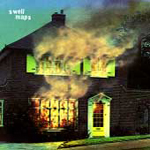
Somewhere inside Plan B Ian Svenonius writes a warning note to Swedish girls. Somewhere within that note, Ian notes that the great English pop groups, from the Kinks, Beatles, Who to the Adverts, Clash, Gang of Four through to the Pop Group, Swell Maps, Smiths, were all ďsimple yobs who had theatre-connected modish homosexuals pulling the stringsĒ. Itís an Interesting theory, though I do wonder who was whispering ďconceptual titbitsĒ into the ears of the Swell Maps.
The September/October edition of Plan B mentions the Swell Maps at least twice. I had completely forgotten how great a pop record their A Trip To Marineville was. It came out on Rough Trade in 1979 and, as with their comrades the TV Personalities, Iíve had an on-off love affair with them ever since. It is a sprawling mess, but it contains some of the most joyous and absurdly sublime pop hooks youíll ever come across. Didnít Paul Morley once call them the Spike Milligans of punk?
Elsewhere in this Plan B there is an infectiously enthusiastic review of This Is A Modern Life, a chronicle of the 1980s London mod scene. Itís a book well worth having, though I warn you it could evoke feelings of revulsion as well as exhilaration if you canít accept humans are fundamentally flawed.
The story essentially is one of single-minded obsession. Itís kids creating their own underground pop scene, based on self-imposed strict music and dress codes. Itís all about doing-it-for-yourself because no other bastard ever will ≠ a theme more traditionally associated with the punk and house scenes which bookend this era.
Some of the pictures are fantastic, and the sceneís faces really did live the Pete Meaden thing, keeping the mod thing going in difficult circumstances. For while the book is rubbish at creating a proper context for the mod thing in the early Ď80s, it does an excellent job at explaining just how hard it was to be an out-and-out mod in those days in good old London.
To go out on your own of an evening in 1981 in South East London dressed even remotely as a mod was positively suicidal. As the book details, the area was swarming with skinheads of all sorts, neo-nazis, members of the British Movement, and they really did not like to see young kids dressed in crombies, crew neck jumpers, desert boots. They didnít just not like mods, they went out of their way to hurt them Ö a lot. I was really into the look, and the details of mod history and philosophy, but didnít want to be part of the exclusively mod world. There was too much else going on. But some things come back reading this book, and in particular the unwritten rule that you never ever went upstairs on a bus to avoid getting trapped.
While some of these kids were missing out on an awful lot by being exclusively mod-oriented ≠ from Postcard to A Certain Ratio to The Fall to the Marine Girls to the Jasmine Minks to the June Brides to McCarthy ≠ you have to concede life wasnít easy for them. Again the book does a good job of highlighting how the recycling of popular culture we take for granted now just did not exist then ≠ outside of the religiously observed scouring round the charity shops we had to indulge in. Now you donít even have to leave your home to be able to order an Attack compilation, a Dave Godin Deep Soul collection, an Italian Sandie Shaw CD. Now your high street TK Maxx gives access to quality clothing at reasonable prices. Such stuff just wasnít around then.
My issue with that whole scene always was its insularity, but I can do nothing but approve of the enterprise culture that generated so many club nights and fanzines, and the learning curve that led from The Jam through Ď60s soul and ríníb to modern jazz to acid jazz. And I am informed that one of the fanzine articles replicated here is the ďhorrified modernistĒ Lynne Humphries tale of being an extra on the set of Absolute Beginners, which was thought to be long lost and only ever to be remembered as a passing reference in another fanzine called The Same Sky.
What the book fails to do is explain to outsiders why the second generation mod scene took off from 1979 onwards, but then in many ways thatís another story and all to do with Paul Weller and The Jam and his own very personal obsession. Itís also a story that I had taken for granted ≠ rather like The Jam themselves. So Iíve been listening to The Jam again when Iíve not been listening to the Swell Maps ≠ because thatís what mods were wont to do in 1979. Just listen to 'BLAM!!' on A Trip To Marineville alongside anything on Sound Affects, and it all fits.
© 2004 John Carney